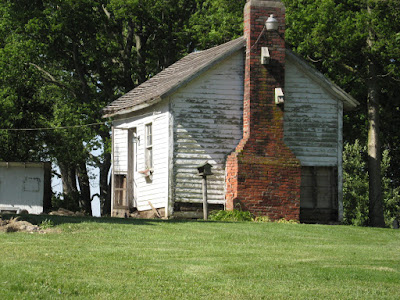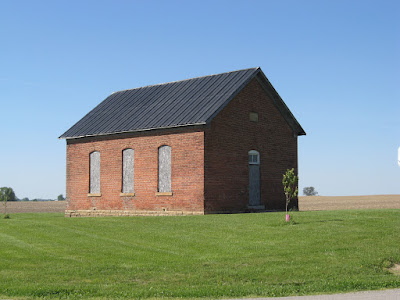A few miles south and west of Columbus we left the city behind and came to tiny towns surrounded by farmland. The farmlands are dotted with farmsteads, many built before 1900. I was surprised at how may of them had summer kitchens. I took a photo of only one -- we whizzed by the others.
A summer kitchen is a small building about the size of a one-car garage which, in times past, had the accommodations of a regular kitchen. They are situated near the house. A summer kitchen was used when a farm wife didn't want the heat of kitchen work -- baking, cooking, heating water for laundry, etc. -- to heat the living space beyond that provided by the summer weather. The kitchen stove from the farmhouse was often moved to the summer kitchen.
You can tell a summer kitchen by its placement near the house, by the regular doors and windows, and by the chimney. They've gone into disuse and often look like small barns or garages these days but they don't have the wide doors required for a garage. I've seen summer kitchens in both Ohio and Pennsylvania. I always look for them when we're driving in the country.
It was wonderful to see the tractors harvesting hay, creating great round bales perhaps 5' tall. We also saw one farm making the smaller, rectangular bales but I didn't get a photograph.
The hay smelled fresh and sweet. I wondered about the term hay fever but decided it probably wasn't related particularly to hay itself. If it did, poor farmer with hay fever who needed to bale hay.
I didn't want to ask my daughter to stop every five minutes for photos -- there were that many beautiful sights -- so I only took a few.
When we reached the corner of Burnett Perrill Road and Miami Trace there were two photos I wanted to take and my daughter willingly stopped.
There was an old schoolhouse. Someone is taking care of this building. Isn't it in grand condition, even without glass in the windows?!
It sits on perhaps an acre of land. It was easy to imagine the children of more than a decade ago walking or riding a horse to school. Had there been glass in the windows I would have peeked inside.
From this photo you will guess that either the sign was crooked or the building was leaning precariously.
It was a barn with a a barn quilt securely affixed to the end.
We wondered how the barn continues to stand, it seems to be leaning so precariously. It's true that a tornado would probably flatten it or scramble it to pieces in a quick minute, but I suspect demolishing it by hand would require lots of work. I remember my brother telling me about a outbuilding, a small shed, on my parents' property that was leaning far to one side. My father decided to take it down and he and my brother set to work. My brother said it looked like it could be easily pushed over but it wasn't so. It was very hard work to take it apart. No doubt it would be the same with this barn.
Here's a closer look at the barn star. I don't know why I didn't walk around to the side and take a photo of just it.
I hope you're doing whatever's necessary to keep your spirits up and not feel overwhelmed by the challenges America and its people are currently facing.
--Nancy.
.






Looks like a fun drive! My mother's aunt had a summer kitchen--I only remember it being used once though. I would spend summers in SD at my grandma's farm and Aunt Josie's farm was nearby. The farm next to grandma's had the old schoolhouse in their cornfield (where my mother's went to school by goat cart--lol). They had the schoolhouse hauled to their yard next to the chicken coop and us kids spent many hours pretending we were at school on our summer vacations. Sure wish I had saved some of those old books!
ReplyDeleteIt was fun! Oh my goodness, what fun memories you have, Karen. Do you do family history and have you written down these memories? If not the books, were you able to take and save photographs?
DeleteNothing like a nice leisurely drive. I remember as a child doing that on Sunday afternoons, usually with several family members packed into the car. DH and I love to do it now. That little schoolhouse was so sweet.
ReplyDeleteHi, Jennie. It seems like the leisure of Sunday afternoon drives has gone by the wayside for most people. I wonder if that happened when gas prices went up in the 1970s -- when we thought $1.00/gallon was an exorbitant price. When I was a child in the 50s our family, like yours, went for drives on Sunday afternoons. Perhaps I can persuade my husband that it would be a good thing to begin.
DeleteThis area reminds me of outlying farms in Idaho where my father was raised. But his old schoolhouse sitting out in the middle of nowhere has not been kept up so well--or at all. I enjoyed going along on your journey with you, and seeing the fun sites that caught your eye. Love that barn quilt, and what an interesting leaning structure.
ReplyDeleteHay fever for me has definitely meant an allergy to alfalfa, which was tricky when playing in the haystack at my grandpa's farm. Also when attending a barn dance in college--in an actual barn, or when DH tried to have me help buck bales early in our relationship.
Thank you, Janet. I'm sorry to learn that hay really does cause hay fever. How sad -- and limiting -- to live in a rural environment.
DeleteI think the hay and schoolhouse photos look similar to areas all over rural areas in the U.S. It is surprising to me to remember that just a generation ago children who lived in rural areas still went to one room schoolhouses.
What a lovely Sunday drive. Driving around is something I miss doing (no car in the city). Thanks for taking us along. Maybe the barn is trying hard to stay upright, for the quilt's sake;).
ReplyDeleteThanks, Cynthia. I forgot, or maybe didn't realize, that you don't have a car just now. And it wouldn't be the same taking a bus or a train for a Sunday afternoon drive, would it?
DeleteI like that idea of the barn working to stay upright for the benefit of the quilt. I often imagine inanimate objects have feelings. Poor things. ;-)